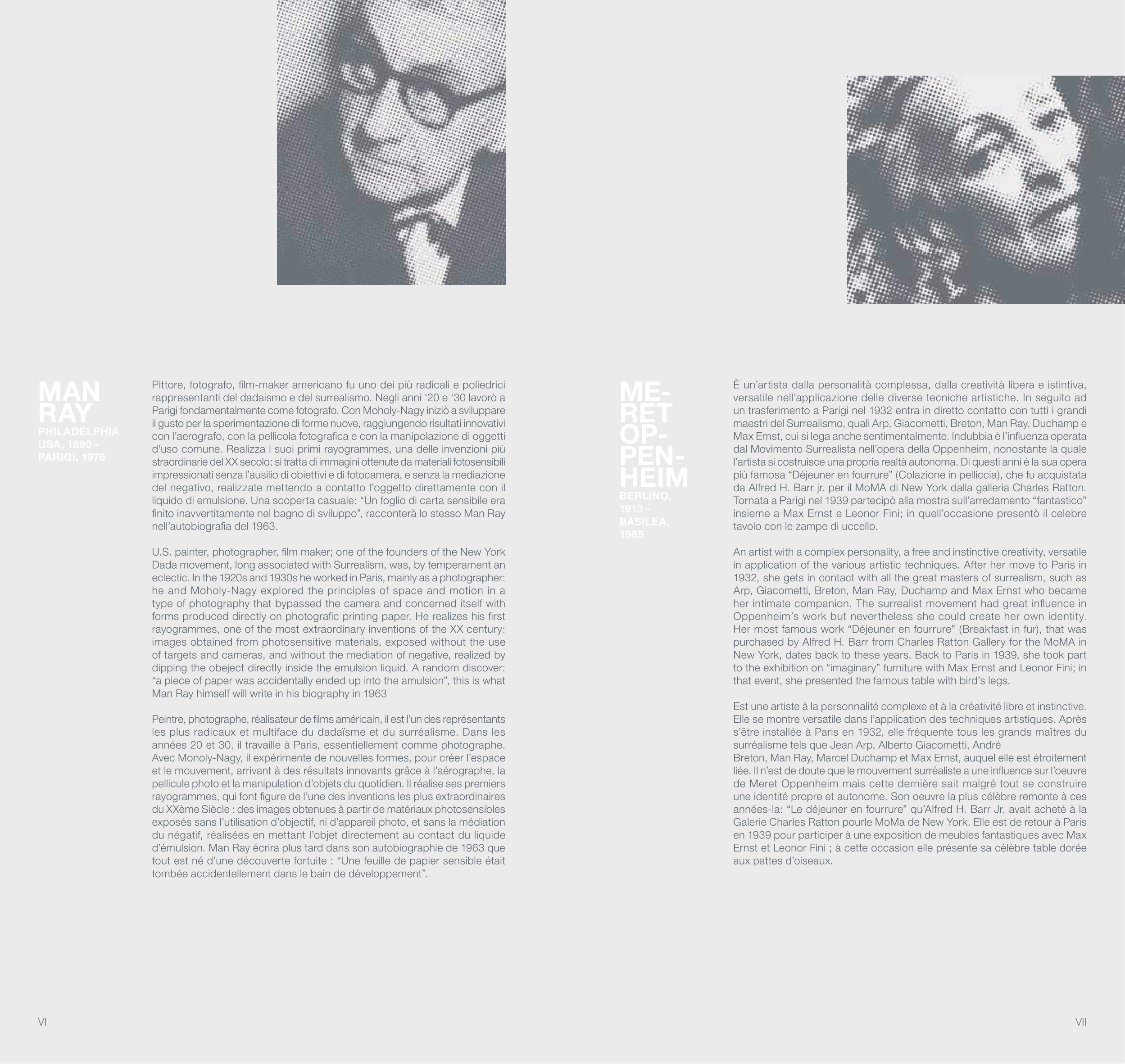È un’artista dalla personalità complessa, dalla creatività libera e istintiva,
versatile nell’applicazione delle diverse tecniche artistiche. In seguito ad
un trasferimento a Parigi nel 1932 entra in diretto contatto con tutti i grandi
maestri del Surrealismo, quali Arp, Giacometti, Breton, Man Ray, Duchamp e
Max Ernst, cui si lega anche sentimentalmente. Indubbia è l’influenza operata
dal Movimento Surrealista nell’opera della Oppenheim, nonostante la quale
l’artista si costruisce una propria realtà autonoma. Di questi anni è la sua opera
più famosa “Déjeuner en fourrure” (Colazione in pelliccia), che fu acquistata
da Alfred H. Barr jr. per il MoMA di New York dalla galleria Charles Ratton.
Tornata a Parigi nel 1939 partecipò alla mostra sull’arredamento “fantastico”
insieme a Max Ernst e Leonor Fini; in quell’occasione presentò il celebre
tavolo con le zampe di uccello.
An artist with a complex personality, a free and instinctive creativity, versatile
in application of the various artistic techniques. After her move to Paris in
1932, she gets in contact with all the great masters of surrealism, such as
Arp, Giacometti, Breton, Man Ray, Duchamp and Max Ernst who became
her intimate companion. The surrealist movement had great influence in
Oppenheim’s work but nevertheless she could create her own identity.
Her most famous work “Déjeuner en fourrure” (Breakfast in fur), that was
purchased by Alfred H. Barr from Charles Ratton Gallery for the MoMA in
New York, dates back to these years. Back to Paris in 1939, she took part
to the exhibition on “imaginary” furniture with Max Ernst and Leonor Fini; in
that event, she presented the famous table with bird’s legs.
Est une artiste à la personnalité complexe et à la créativité libre et instinctive.
Elle se montre versatile dans l’application des techniques artistiques. Après
s’être installée à Paris en 1932, elle fréquente tous les grands maîtres du
surréalisme tels que Jean Arp, Alberto Giacometti, André
Breton, Man Ray, Marcel Duchamp et Max Ernst, auquel elle est étroitement
liée. Il n’est de doute que le mouvement surréaliste a une influence sur l’oeuvre
de Meret Oppenheim mais cette dernière sait malgré tout se construire
une identité propre et autonome. Son oeuvre la plus célèbre remonte à ces
années-la: “Le déjeuner en fourrure” qu’Alfred H. Barr Jr. avait acheté à la
Galerie Charles Ratton pourle MoMa de New York. Elle est de retour à Paris
en 1939 pour participer à une exposition de meubles fantastiques avec Max
Ernst et Leonor Fini ; à cette occasion elle présente sa célèbre table dorée
aux pattes d’oiseaux.
Pittore, fotografo, film-maker americano fu uno dei più radicali e poliedrici
rappresentanti del dadaismo e del surrealismo. Negli anni ‘20 e ‘30 lavorò a
Parigi fondamentalmente come fotografo. Con Moholy-Nagy iniziò a sviluppare
il gusto per la sperimentazione di forme nuove, raggiungendo risultati innovativi
con l’aerografo, con la pellicola fotografica e con la manipolazione di oggetti
d’uso comune. Realizza i suoi primi rayogrammes, una delle invenzioni più
straordinarie del XX secolo: si tratta di immagini ottenute da materiali fotosensibili
impressionati senza l’ausilio di obiettivi e di fotocamera, e senza la mediazione
del negativo, realizzate mettendo a contatto l’oggetto direttamente con il
liquido di emulsione. Una scoperta casuale: “Un foglio di carta sensibile era
finito inavvertitamente nel bagno di sviluppo”, racconterà lo stesso Man Ray
nell’autobiografia del 1963.
U.S. painter, photographer, film maker; one of the founders of the New York
Dada movement, long associated with Surrealism, was, by temperament an
eclectic. In the 1920s and 1930s he worked in Paris, mainly as a photographer:
he and Moholy-Nagy explored the principles of space and motion in a
type of photography that bypassed the camera and concerned itself with
forms produced directly on photografic printing paper. He realizes his first
rayogrammes, one of the most extraordinary inventions of the XX century:
images obtained from photosensitive materials, exposed without the use
of targets and cameras, and without the mediation of negative, realized by
dipping the obeject directly inside the emulsion liquid. A random discover:
“a piece of paper was accidentally ended up into the amulsion”, this is what
Man Ray himself will write in his biography in 1963
Peintre, photographe, réalisateur de films américain, il est l’un des représentants
les plus radicaux et multiface du dadaïsme et du surréalisme. Dans les
années 20 et 30, il travaille à Paris, essentiellement comme photographe.
Avec Monoly-Nagy, il expérimente de nouvelles formes, pour créer l’espace
et le mouvement, arrivant à des résultats innovants grâce à l’aérographe, la
pellicule photo et la manipulation d’objets du quotidien. Il réalise ses premiers
rayogrammes, qui font figure de l’une des inventions les plus extraordinaires
du XXème Siècle : des images obtenues à partir de matériaux photosensibles
exposés sans l’utilisation d’objectif, ni d’appareil photo, et sans la médiation
du négatif, réalisées en mettant l’objet directement au contact du liquide
d’émulsion. Man Ray écrira plus tard dans son autobiographie de 1963 que
tout est né d’une découverte fortuite : “Une feuille de papier sensible était
tombée accidentellement dans le bain de développement”.
ME-
RET
OP-
PEN-
HEIM
BERLINO,
1913 -
BASILEA,
1985
MAN
RAY
PHILADELPHIA
USA, 1890 -
PARIGI, 1976
VI
VII


